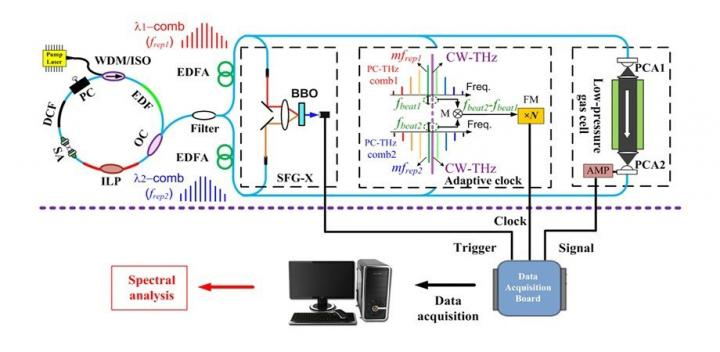Jun 9 2020
Spectroscopy was the result of the thirst for knowledge about interactions that occur between electromagnetic radiation and matter in the early 19th century.
 Configuration of comb-mode-resolved adaptive sampling THz-DCS, from Chen et al. Image Credit: SPIE.
Configuration of comb-mode-resolved adaptive sampling THz-DCS, from Chen et al. Image Credit: SPIE.
Advances in materials science and electronics have enabled the regular use of different spectroscopy techniques to analyze the composition of materials and the nature of their chemical bonds by investigating how they reflect or absorb electromagnetic waves.
Different materials exhibit distinct absorption profiles over a wide array of frequencies. Some vital features in specific molecular systems, such as the hydrogen bonds in aqueous systems or the self-assembly of proteins, can be useful in their absorption profiles only at frequencies of the order of terahertz (THz or 1000 billion Hertz), which is a near-infrared range.
Spectroscopy techniques compatible with such high frequencies have been developed by researchers, one among which is the so-called THz dual-comb spectroscopy. In the terahertz range, this technique provides various benefits over others, but it has not been used much due to the high complexity of the measurement system, which usually needs two independent stable lasers as the radiation sources.
At present, researchers from Tokushima University, Japan; Beihang University, China; and Université du Littoral Côte d'Opale, France, have proposed an innovative scheme for THz dual-comb spectroscopy that needs just a single laser source while still offering an excellent resolution.
Gaining insights into the main aspects of their technique could help understand the fundamentals of THz dual-comb spectroscopy. The term “dual-comb” implies that the laser pulses, when plotted against frequency, resemble a series of equally spaced spikes (spectral lines) over a wide frequency range in the terahertz region, and thus a “comb.”
Dual-comb spectroscopy involves the use of two lasers with somewhat different “combs” to quantify a sample’s absorption profile. The nature of the system makes the actually measured signal—resulting from the “mixing” of the two combs—to occupy a considerably lower frequency range. It still reflects all the high-frequency information of interest. However, using two lasers can lead to a problem with stabilization control.
The researchers tackled the stabilization problem by using a single laser to create both the combs. But when the same laser source is used to create both the combs, the high-frequency information reflected in the final measured low-frequency signal is blurred by a timing instability or “jitter.”
A technique known as adaptive sampling was used to correct this undesirable phenomenon. In this technique, instead of sampling the signal to be digitally obtained at equal time periods, the sampling is performed at particular times computed to reduce any errors or drifts in the relative timing between combs.
The researchers demonstrated their technique by performing measurements on a mixture of air and the compound acetonitrile. This unique gas shows characteristic features upon irradiation with terahertz radiation. Most significantly, these features differ slightly with pressure.
Since these variations are extremely small, they could not be detected by earlier dual-comb spectroscopy methods that used a single laser, due to their limited resolution. On the contrary, the scheme reported in this study could be used to precisely visualize several of these features. An exceptionally narrow absorption linewidth (25 MHz) was reported by the researchers—the first realized using a dual-comb fiber laser.
The team has already been working on another complementary method that could further enhance the resolution of THz dual-comb spectroscopy using a single laser. The minimization of system complexity achieved by using the adaptive sampling technique could expand the areas of application of accurate THz spectroscopy, thus offering scientists with a robust yet simple tool for further exploration of the material world.
Journal Reference:
Chen, J., et al. (2020) Adaptive-sampling near-Doppler-limited terahertz dual-comb spectroscopy with a free-running single-cavity fiber laser. Advanced Photonics. doi.org/10.1117/1.AP.2.3.036004.